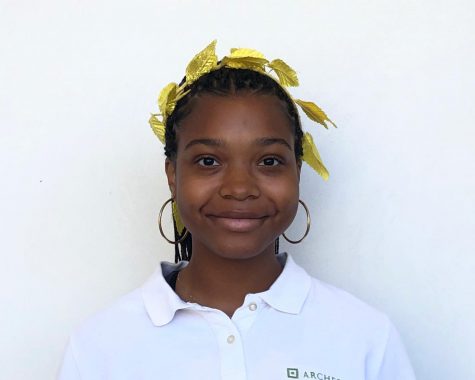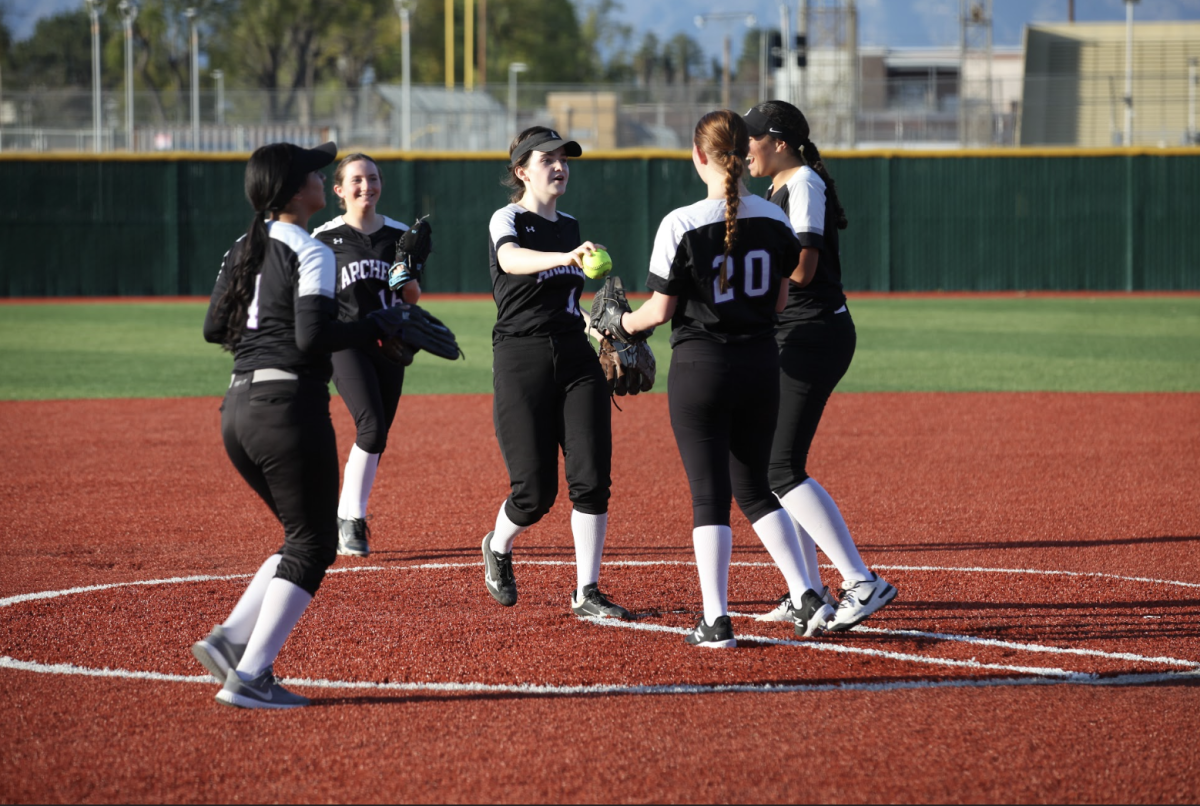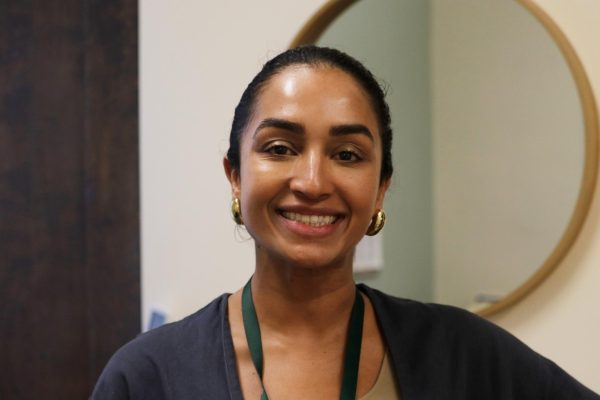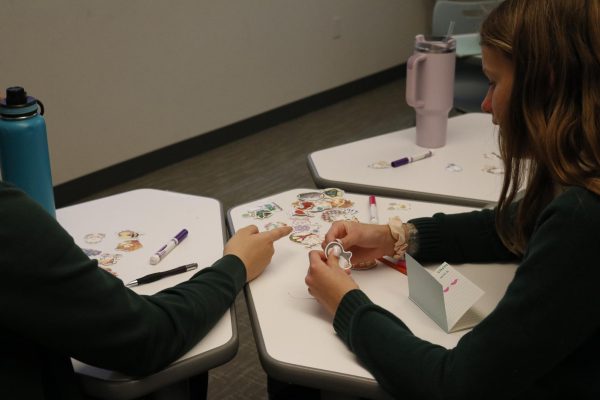‘It would just be nice to see someone who looked like me’: Community members reflect on Archer diversity
Photo credit: Molly Solowitz
This illustration depicts two teachers of color in a classroom with eager students. As of now 23% of Archer’s faculty identify a POC. Digital illustration: Molly Solowitz.
During Archer’s annual Diversity Conference, a school day focused on educating and promoting diversity, students were given the option to split into their affinity groups and debrief after watching the documentary “Documented.” During Black Student Union’s [BSU] debrief, the conversation led to students airing concerns about the diversity within the Archer community and teaching staff.
Research and Statistics
According to research provided by Learning Policy Institute, “Teachers of color boost the academic performance of students of color, including improved reading and math test scores, improved graduation rates, and increases in aspirations to attend college.”
“While white students also benefit by learning from teachers of color, the impact is especially significant for students of color, who have higher test scores, are more likely to graduate high school, and more likely to succeed in college when they have had teachers of color who serve as role models and support their attachment to school and learning.”
Students who have racially diverse teachers also have fewer unexcused absences and are less likely to be chronically absent.
Head of School Elizabeth English addressed the need for faculty and staff diversity at Archer in her Feb. 7 “Eye to Eye” newsletter.
“As our society and independent schools, in particular, have raised their consciousness around issues of racial and cultural diversity, Archer too has been working as an entire community on issues of equity and inclusion,” English wrote.
English said the country is facing challenges not just hiring teachers of color, but also hiring teachers in general.
“The nation is experiencing a full-blown teacher shortage. Attracting, training, and retaining excellent teachers is our number one priority and greatest challenge,” she wrote. “According to the most recent Report on Racial Diversity in the Educator Workforce by the U.S. Department of Education, 18 percent of the teacher workforce is of color, with only 7 percent being African American, 9 percent Hispanic, and 2 percent Asian.”
With only 18% of the Educator Workforce being POC, you can imagine the struggles other independent schools may go through when trying to attain a more diverse faculty. And although Archer has a slightly higher percentage of POC faculty compared to the general educator workforce, it’s still a concern for some members of the community.
Regarding diversity on campus, Archer has made incremental improvements. In 2017, only 16 percent of Archer’s faculty identified as a person of color. Currently, 23% of Archer’s faculty identify as a person of color, along with 56% of staff, and 29% of senior administrators.
“Six out of seven Board Committee Chairs are women, and three are people of color,” English wrote.
English went on to point out Archer’s admissions staff, communications office and technology team are “entirely non-white.”
English went into detail about the recruitment strategies Archer is using to attract more teachers of color, such as “increasing postings on recruiting sites National Alliance of Black School Educators, Southern California People of Color in Independent Schools, attending diversity recruiting events, providing implicit bias training and ongoing DEI professional development to all employees, featuring diversity and inclusion language in all job descriptions, and increasing diversity and inclusion information on our website.”
The school also retains multiple diversity recruiting firms, including NemNet and The Picardy Group.
“We know the focus has to remain on recruiting the most skilled and innovative faculty possible,” English wrote. “Which by necessity means increasing diversity of all kinds among its ranks.”
Perceptions from faculty of color at Archer
Dance teacher Andrea Locke has worked at Archer for 15 years and believes that being a teacher of color impacts the way she teaches and how she’s viewed in the community.
“For students to see me as a person of color in this position who is not only a teacher but has had a career as a dancer, so yes it definitely does [have an impact],” Locke said.
Locke makes an effort to educate her dancers about black culture and its correlation to dance.
“I make a concerted effort to make sure that my students especially know about African American contributors to the art of dance,” she said. “And not just in Black History Month do I talk about the African American contributors to the field of dance.”
When Locke was sending her own children to independent schools, it was a priority of hers that the school had a diverse teaching staff.
“When there are teachers of color in an environment of independent schools, not only does it send a message to the students, but it sends a message to the community,” she said. “That there’s a road into, or a ‘yeah I can do that,’ or hope, or an avenue that maybe they didn’t feel was accessible.”
Locke believes Archer is making an effort to attract more teachers of color, but it might be challenging if said applicant doesn’t feel a sense of community or a familiar environment.
“I think they’re really trying to make a concerted effort to recruit and I think every opening they have an eye on POC,” Locke said.”Honestly, oftentimes people gravitate towards places where there is some kind of relationship.”
“There needs to be — not aggressive recruiting, but not just waiting for people to come and ‘oh I see you have this opening’ more of an active recruitment eye,” Locke said.
Spanish teacher Annie Santana has been working at Archer for nine years and said she feels a ”big responsibility” being a language teacher because she is immersing her students into a new culture.
“It’s much more than Spanish and the traditions, which are beautiful and fun, but it’s also the diversity and the complications that arise from that and the conflicts and appreciating that diversity,” Santana said. “Those kinds of hard truths, the sad history of oppression and discrimination which unfortunately continues today is an important aspect of the class I teach. It gives me the opportunity to really make sure the girls are aware of this.”
Santana believes having different perspectives within the community gives students a chance to learn something new, as opposed to having one story told.
“If we all have the same type of teacher who was raised the same way, we’re only going to see one view and there are so many different perspectives of the world, of the United States, Latin America, of history,” she said.
Santana was drawn to Archer because of the “new” and “unique” environment.
“The uniqueness of Archer was just so appealing to me. Not just from the perspective of all girls, but also from the perspective of the independent [school] and the newness of it,” she said. ”[Archer] wasn’t bogged down by tradition, which is nice.”
Santana recalled her experience teaching at other private schools and what her experience being a woman of color was like there.
“When I was teaching at an all-boys school, there were a handful of girls there and a handful of teachers of color. So I’m used to swimming in a sea of people who are different and have had different experiences than I’ve had,” she said.
Working at Archer over the years has allowed Santana to take an even closer look at the diversity among the teaching staff.
“I’ve become much more aware of noticing the diversity within the faculty, and when a teacher of color leaves, I’m always curious and I wonder why,” she said.
Santana appreciates the support she receives from non-faculty of color and believes it’s important for her as well as her students.
“I think that support is really important for me personally and also for the students. I’m thinking about all the planning that went into Diversity Day and all the conversations,” she said. “The non-POC faculty who reached out to POC faculty to see ‘how do you feel about these conversations,’ and ‘how do we support our students of color while still talking about immigration, which is such a delicate subject,’”
Similar to Santana, for Chinese teacher Pei-Ying Gosselin teaching her students the differences between Chinese and American culture is something really important to her. That is one of the main reasons Gosselin chose to be a language teacher and why she enjoys it so much.
“I’m Chinese, and there [is] a lot of Chinese culture that is very different from American culture,” she said, “I like to be a language teacher because I can teach the students more about diversity and [the] different things between culture.”
Gosselin believes that Archer has made improvements with the diversity among faculty, but is still behind compared to other schools.
“I think it’s getting better, I wouldn’t say it’s diverse compared to a lot of very diverse schools, but it’s definitely [gotten] much better over my time being here,” Gosselin said.
And although Gosselin believes Archer can make some improvements regarding diversifying its staff, she doesn’t think a teacher should be hired for the sole purpose of being a person of color.
“If there are two teachers with the same ability, of course, we want the opportunity to have a diverse experience,” Gosselin said. “We don’t want to hire teachers with color just because they’re a person of color… I would think that compared to having a very good teacher and a diverse teacher, I think good teachers are more important than a diverse teacher.”
One student’s perspective
Freshman Marin Terry has attended Archer for three years. She talked about her reasons for coming to Archer and how she was “let down” when the school wasn’t what she expected.
“They always talked about how diverse it was going to be here. I was excited to be around my people because my old school had no people of color at all,” she said, “Then I came here and it wasn’t [diverse], so that was really weird,”
But with the lack of diversity among the faculty, Terry believes that is a reason why some teachers of color may shy away from applying at Archer and other independent schools alike.
“If [Archer is] interviewing people of color and they come here and they see nobody else that looks like them they’ll ask ‘why is it like this?‘” Terry said.
Terry still thinks Archer’s teaching staff can go a long way when it comes to diversity and representation.
“With the environment, they need to take baby steps,” Terry said. “It’s easy to aim high when you see other people who have achieved things you dream of achieving at such a young age. It would just be nice to see someone who looked like me.”

Cadence Callahan first joined the Oracle as a Staff Reporter in 2019 and was Voices Editor in 2022. She was on the Executive Board of Best Buddies and...





![Freshman Milan Earl and sophomore Lucy Kaplan sit with their grandparents at Archer’s annual Grandparents and Special Friends Day Friday, March 15. The event took place over three 75-minute sessions. “[I hope my grandparents] gain an understanding about what I do, Kaplan said, because I know they ask a lot of questions and can sort of see what I do in school and what the experience is like to be here.](https://archeroracle.org/wp-content/uploads/2024/03/grandparents-day-option-2-1200x800.jpg)
























































Vaughn Jamison • Jun 11, 2020 at 5:04 am
Kudos Cadence! This is well articulated, insightful and informative. This is a well-balanced article that will lead us to greater dialogue about diversity and invite us to sit at the table of change where we can implement strategies that will offer the opportunity called success to all students.
Bethany Neubauer • Jun 10, 2020 at 10:46 pm
This is such a thoughtful and well-researched article. I appreciate your bringing in both student and faculty perspectives, as well as the research on learning and statistics. I hope that Archer can attract and retain more teachers of color so that our faculty can reflect the rich diversity of our student body.
Tracy Poverstein • Jun 10, 2020 at 9:01 am
Thank you for writing this article and for getting so many different perspectives. I also found the statistics useful for the discussion.
Crystal Turner-Callahan • Jun 8, 2020 at 9:23 pm
Thank you for your perspective, Steve.
Crystal Turner-Callahan • Jun 8, 2020 at 9:22 pm
Cadence and I stand with you, Christina. Thank you for your support.
Christina Lincoln-Moore • Jun 8, 2020 at 6:50 pm
Well spoken! The Parents of Black Archer Students supports you, Cadence!
We plan to mobilize and advocate for all our young Black women so that the beauty, brilliance, and our struggles are showcased in the Archer Community on various levels.
PBAS is a community of affirmation and empowerment to acknowledge shared experiences in ways that are productive, valuable, and meaningful. It is a brave space that preserves our dignity as a people. A place where people of similar identity can share how they navigate the complexities of our predominately white independent school.
OUR MISSION
The mission of the Parents of Black Archer Students is to serve as a village for families of the Black Diaspora to affirm their identity, build community, and cultivate leadership in order to empower families to deepen their engagement and to enrich the Archer community.
OUR PURPOSE
• Discuss topics of race, identity, and diversity in a safe space that will enable students of color to develop their voice.
• Increase the school’s ability to recruit and retain families and teachers of color.
• Provide a majority experience for students regularly who are in the minority.
Who will stand with us?
Steven Porter • Jun 7, 2020 at 3:35 pm
This article is eloquently done and very informative. I’ve come to appreciate the idea and the importance of having Teacher’s of similar cultural backgrounds playing an important role in a child’s cademic development.
Crystal • Jun 7, 2020 at 1:09 pm
Great article! Very informative and interesting